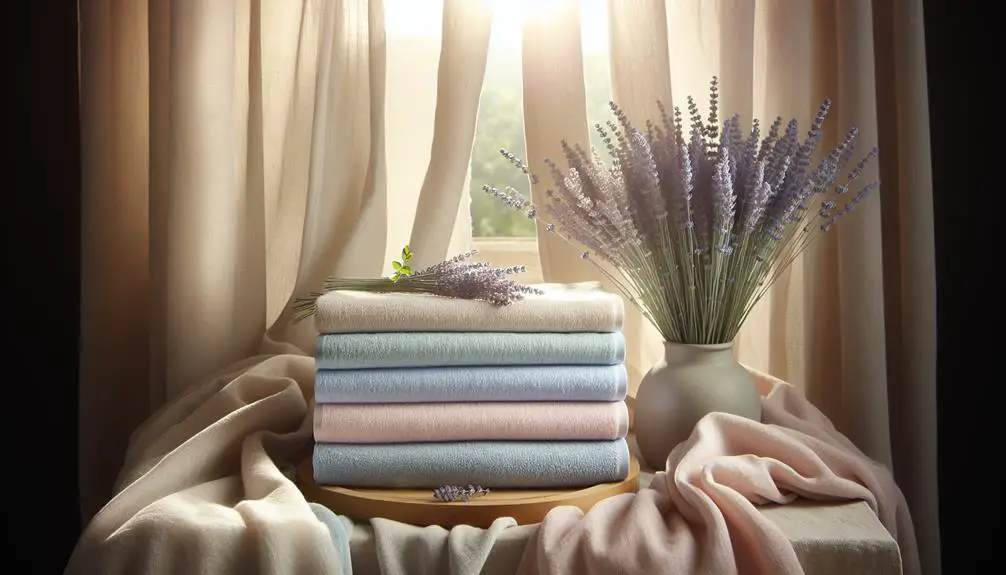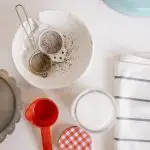I've always been a fan of linen for its breathability and elegance, but keeping it soft can be a bit of a challenge. Over the years, I've learned that the secret isn't just in washing it properly, but also in the little things you do long before and after laundry day. From the gentle dance of baking soda in the wash to the subtle art of drying, there's a lot to unpack. And don't get me started on the magic of white vinegar—it's a game-changer. But, there's one tip, in particular, that's transformed my linen care routine. Stick around, and I'll share how to turn that stiff linen into the soft, inviting fabric we all love.
Table of Contents
Key Takeaways
- Wash linen garments regularly with mild detergent on a gentle cycle to gradually soften them.
- Incorporate natural softeners like white vinegar or baking soda in the wash to enhance softness without harsh chemicals.
- Use drying balls in the dryer to increase fabric friction, softening the linen and reducing drying time.
- Lay linen items flat to dry or air-dry on sunny days to maintain shape and minimize wrinkles for a softer feel.
- Avoid overuse of fabric softeners, as they can reduce linen's breathability and absorbency, opting for natural alternatives instead.
Understanding Linen's Texture
To get why linen feels a bit rough at first, it's important to look into its unique texture, woven from the strong fibers of the flax plant. These fibers, while natural and incredibly durable, lend the fabric a texture that's not immediately soft to the touch. It's those tightly woven, long, narrow warp threads, made of dense and sturdy bast fibers, that give linen its distinctive feel.
At first, this mightn't sound ideal, especially if you've got sensitive skin that doesn't take kindly to anything less than super soft. The initial stiffness of linen sheets can indeed cause a bit of discomfort, but here's the thing – this fabric is a bit like fine wine; it gets better with time. Understanding this texture is crucial because it's the first step in figuring out how to soften linen without compromising its strength or beauty.
Regular Washing Techniques
Understanding linen's texture sets the stage for exploring how regular washing techniques can play a significant role in softening this durable fabric.
I've found that the key to keeping my linen garments soft is washing them multiple times. This process helps remove any additives and encourages the fabric to become more pliable. From the get-go, I always use gentle cycles and mild detergents. This careful approach prevents damage and sets the stage for achieving that sought-after softness.
I've also learned not to overload my washing machine. Giving linen enough room to move freely in the drum significantly contributes to its softening process. And when it comes to drying, laying linen items flat is my go-to method. It helps maintain their shape and minimizes wrinkles, making them easier to manage.
Incorporating regular washing with natural softening agents, although I won't dive into specifics like vinegar here, has been a game-changer. It's a simple, effective strategy that ensures my linen stays soft over time. Adopting these techniques hasn't only enhanced the texture of my linen garments but also extended their lifespan, making them a comfortable and enduring part of my wardrobe.
The Magic of White Vinegar
Now, let's talk about the magic of white vinegar in keeping our linen soft.
I've discovered that adding a bit of white vinegar to the wash does wonders for softening up those fabrics.
It's all about stripping away the stuff we don't see that makes our linen stiff, and honestly, it's been a game-changer for me.
Vinegar Rinse Benefits
White vinegar, often hailed as a laundry miracle, effortlessly strips away detergent residue, making your linens softer and more comfortable. When I add it to the rinse water, it's like giving my linen fabrics a spa treatment.
It balances the pH level, which is a game-changer for softening linen fabric. I've noticed it prevents stiffness, preserving the natural texture that I love about linen. Plus, using white vinegar in my wash cycle helps remove any roughness, making my linens feel incredibly smooth.
It's fascinating how this natural ingredient can so effectively enhance the softening process. Honestly, white vinegar has become my go-to for keeping my linens feeling cozy and inviting.
Softening Process Explained
Let's dive into how white vinegar works its magic, making our linens softer than ever before. This humble kitchen staple is more than just a condiment; it's a powerful softening agent for our beloved linen fabric. When we add white vinegar to the rinse water, it acts like a charm by stripping away any residual detergent clinging to the natural fibers. This not only helps in cleaning but significantly enhances the softness of the fabric.
The secret lies in its ability to balance the pH level, ensuring our linen remains gentle and luxurious to the touch. Even soaking linen sheets overnight in a white vinegar and water mixture can leave them feeling incredibly soft. It's simple, effective, and, most importantly, gentle on our natural fibers.
Baking Soda for Softness
Now, let's chat about how baking soda can up our linen softening game. It's pretty amazing at balancing the pH levels during the rinse, making our linens feel super soft.
I'll also show you a couple of easy ways to use it in your washing routine to keep your linens feeling cozy without the harsh chemicals.
Baking Soda Benefits
I've discovered that using baking soda not only keeps my linen feeling soft but also avoids the need for harsh chemicals. Here's why baking soda has become my go-to for linen care:
- Natural Softening: Baking soda naturally regulates pH levels during the wash cycle, ensuring the linen fabric stays soft without the use of additives.
- Consistent Comfort: Adding baking soda to every wash helps maintain a stable pH level, promoting consistent softness in all my linen items.
- Gentle on Fabrics: It's a gentle, natural way to soften linen, ensuring my fabrics aren't exposed to potentially damaging chemicals.
Incorporating baking soda into my linen care routine has truly made a difference, keeping everything feeling wonderfully soft and comfortable.
Application Techniques
Mastering the application of baking soda can transform your linen care routine, ensuring your fabrics stay irresistibly soft. Using baking soda to soften linen is all about regulating pH levels. It's a game-changer for those flax fibers! Here's a quick guide to get you started:
| Method | How It Works |
|---|---|
| Washing Machine | Add 1/2 cup to your rinse cycle. |
| Soaking | Dissolve in a tub for tough linens. |
| Maintenance | Regular use keeps linen garments soft. |
The Importance of Drying Balls
Understanding the role of drying balls can significantly elevate the softness of your linen sheets. When I first discovered these nifty little helpers, I was amazed at how they transformed my linens from somewhat stiff to incredibly soft and inviting. Here's how they work their magic:
- Increase Fabric Friction: Drying balls create gentle friction against the linen as they tumble around in the dryer. This action helps soften the fabric, making your sheets feel cozy and comfortable against your skin.
- Reduce Drying Time: These little wonders also reduce the overall drying time. By improving the airflow within the dryer, they prevent your linen from becoming stiff and unyielding, preserving that much-desired softness.
- Eco-Friendly Softening: Opting for drying balls is a green move. Unlike chemical softeners, they don't leave behind any residue or harm the environment. Plus, their massaging action relaxes linen fibers, making them feel softer after each wash.
Incorporating drying balls into your laundry routine is a simple yet effective step towards achieving that dreamy softness in your linen. Not only do they enhance comfort, but they're also an eco-friendly choice for maintaining the quality and feel of your sheets.
Ironing for Ultimate Softness
After discovering the magic of drying balls, I found that ironing linen while it's still a tad damp takes softness to another level. Ironing isn't just about getting rid of those pesky wrinkles; it's a crucial step in pampering those flax fibers, making your linen feel like a cozy embrace.
The heat and pressure work wonders, smoothing out creases and enhancing the fabric's natural softness. But, it's not just about running an iron over it; there's an art to it. Proper techniques make all the difference, ensuring your linen remains a staple of comfort in your life.
Here's a quick guide to get you started:
| Step | Tip | Why It Works |
|---|---|---|
| 1 | Use a steam iron | Moist heat helps soften fibers |
| 2 | Iron on reverse | Protects fabric surface |
| 3 | Keep it damp | Eases out wrinkles more effectively |
| 4 | Regular care | Maintains softness over time |
Softer With Each Wash?
While ironing does wonders for softening linen, it's the washing process that truly makes each piece more comfortable over time. I've found that the secret to keeping my linen sheets invitingly soft involves a few simple tweaks to the usual laundry routine. It's pretty amazing how these natural fibers, derived from the flax plant, respond to care and attention.
Here's what I do to ensure my linens get softer with each wash:
- Use Warm Water and Mild Detergent: Linen loves warmth. Washing it in warm water, not hot, with a gentle detergent helps relax the fibers. This process gradually eases the initial stiffness you often feel with new linen products.
- Add a Natural Softener: Instead of traditional fabric softener, I opt for a half cup of baking soda or vinegar in the wash cycle. These natural alternatives break down any lingering stiffness and don't coat the fibers, allowing them to become more supple.
- Ditch the Dryer Sheets for Dryer Balls: When it's time to dry, I use wool dryer balls. They not only help to soften the linen but also prevent clumping, ensuring even drying and further enhancing the softness.
Following these steps, I've noticed my linen items don't just soften; they become treasures of comfort.
Identifying Soft Linen Types
When I started my journey to find the softest linens, I quickly learned that not all linens are created equal. It turns out, the quality of the linen fibers and the way they're woven play huge roles in how soft the fabric feels.
Linen Fiber Quality
Exploring the world of linen, I've discovered that not all types are created equal, especially when it comes to softness. To help you master the art of keeping your linen soft, here's a quick guide:
- Damask and Venice Linen: These are my go-tos for ultra-soft linen bedding and clothing. Their luxurious feel and smooth texture are unbeatable.
- Loosely Woven and Huckaback Linen: Perfect for those airy, soft towels and bath linens. Their absorbency and lightweight feel make them a bathroom essential.
- Belgian Linen: The king of softness, thanks to its long-staple flax fibers. It's what I always recommend for the ultimate soft touch in natural fibers.
Weave Patterns Matter
Now that we've looked at different types of soft linen, let's focus on how weave patterns play a significant role in determining their softness.
Damask and Venice Linen both boast unique, intricate weave patterns that not only enhance their texture but also their soft feel. It's fascinating how these patterns contribute to the overall plushness.
Then there's the open weave structure found in loosely woven linens, which adds an airy softness that's hard to beat. Huckaback Linen, with its distinctive pattern, offers a soft and plush feel that's truly comforting.
But the crown jewel? True Belgian Linen. Its specific weave combined with high-quality flax fibers makes it the softest linen around. It's clear that when it comes to softness, the weave patterns and the quality of linen fibers matter immensely.
The Role of Fabric Softeners
I've found that while fabric softeners might promise softer linen, they often come with a downside, like reduced absorbency and breathability. It's tempting to reach for them, hoping for that cozy, soft feel, but I've learned they can actually do more harm than good. They coat the linen fibers, making them less effective at their job, whether that's drying you off after a shower or keeping you cool on a hot night.
Here's what I've focused on instead:
- Gentle Washing: I stick to gentle washing methods, avoiding harsh detergents and opting for a softer approach to preserve my linen's natural qualities.
- Natural Alternatives: Before diving into the specifics in the next section, I leaned towards using items like white vinegar and baking soda in my laundry routine. They're kind to the environment, gentle on the linen fibers, and don't irritate my skin.
- Avoiding Overuse: I learned the hard way that less is more. Using too much fabric softener can lead to buildup, making my linen stiff over time.
Natural Softening Alternatives
Given the drawbacks of fabric softeners, let's focus on natural alternatives that keep linen soft without the unwanted side effects. Who knew that something as simple as white vinegar could be a hero in the linen wash? It's true! Adding white vinegar to the rinse water can strip away residues and balance pH levels, naturally softening linen. I've even tried soaking my linen sheets in a vinegar and water mix overnight, and the softness it adds is simply remarkable.
Creating a natural fabric softener with white vinegar and water in a spray bottle has become a go-to method for me. It's an effective, easy way to soften linen items without any harsh chemicals. And let's not forget about baking soda. Tossing a bit into every wash helps maintain that consistent pH level and aids in the softening process.
I've found that regular washing, along with these specific softening techniques, makes my linen items progressively softer. There's something incredibly satisfying about achieving that perfect softness naturally. So, if you're looking to keep your linen feeling luxurious, give these natural alternatives a try.
Maintaining Linen's Luxurious Feel
Maintaining the luxurious feel of linen doesn't have to be a challenge, especially when you're armed with the right care tips. Given the natural fibers of linen, it's essential to treat them with care to preserve their softness and durability. Here's how I ensure my linen stays soft and inviting:
- Wash with Care: I always opt for a mild detergent and avoid harsh chemicals. If I feel my linen needs a bit of brightening, I'll add a little baking soda to the wash. It's a gentle way to keep them looking fresh without damaging the fibers.
- Dry Gently: Instead of tossing them in the dryer, I air dry my linen garments. It prevents shrinkage and helps maintain that luxurious feel. On a sunny day, nothing beats the natural freshness that comes from air-drying.
- Ironing for Excellence: To keep that crisp yet soft feel, I lightly iron linen when it's still slightly damp. Using white vinegar in the iron's water can add an extra level of softness. Plus, it's a natural alternative to fabric softeners.
Following these steps, I've found my linen items not only maintain their quality but also their comforting, luxurious touch.
Frequently Asked Questions
Is There a Way to Make Linen Softer?
Yeah, making linen softer is totally doable! I've found using natural softeners like vinegar and baking soda, tossing in some dryer balls, and gently massaging the fibers really helps. Always follow the care instructions, though.
Does 100% Linen Soften?
Yes, 100% linen definitely softens over time. Each wash and use makes it more flexible and comfortable. I've found that gentle detergents and air drying, along with avoiding harsh chemicals, really help maintain its softness.
How Do You Make Linen Last Longer?
I make my linen last longer by washing it in cold water, avoiding harsh chemicals, and air drying it. Storing it properly also helps. Following these steps keeps my linen looking great for years.
Why Is My Linen Hard?
I've noticed my linen's hard because of its natural stiffness and sometimes those finishes they use. Plus, not rinsing out all the soap doesn't help. I'm learning the right ways to wash and dry it.
- How Does Ring Spun Cotton Affect Garment Fit and Shape Retention? - August 13, 2024
- What Are the Challenges in Producing Ring Spun Cotton? - August 13, 2024
- Is Ring Spun Cotton Suitable for Plus-Size Clothing? - August 13, 2024







